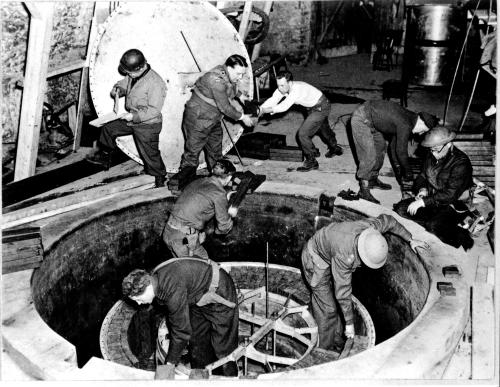In 1945, The United States was pouring resources into the Manhattan Project to create an atomic bomb. Part of the reason that the Manhattan Project was started in the first place was the knowledge that Germany was working on their own atomic bomb project. Werner Heisenberg was heading a team to develop a nuclear weapon for Germany but the German government failed to invest enough resources for the project to make much progress. In March of 1945, Kurt Diebner was assigned the task of making a prototype German atomic bomb in Ohrdruf, Thuringia. Research was carried out at an experimental nuclear reactor at Haigerloch.
Following Germany’s surrender in May of 1945, Project Alsos was initiated by the United States. A team of scientists followed the Allied troops into Germany to investigate the German nuclear weapons program and prevent the Russian army coming in from the east from collecting any information, equipment or personnel that might help them create their own nuclear weapons program. Project Alsos reported that although the Germans did have a nuclear weapons program, they were not even close to creating an atomic bomb by the time the war ended.
The horrendous damage done by the two atomic bombs dropped on Hiroshima shocked the world. The world had entered a dangerous new age of nuclear weapons of tremendous destructive power. A intense international debate raged over the question of who should control nuclear weapons. Many of the scientists who had worked on the Manhattan Project lobbied international control of such weapons. They suggested that either an international agency be formed for the purpose of controlling nuclear weapons or that the information on how to build such weapons be distributed to all the major powers. It was not surprising that the United States, the only world power which had possession of nuclear weapons, was not enthusiastic about giving away such a strategic advantage over all other nations. The deep distrust that the U.S. had for the Soviet Union following the war encouraged the U.S. to work to maintain a monopoly on nuclear weapons.
The idea of using a fission bomb to ignite a much more powerful fusion bomb had been proposed in 1942 by Edward Teller but rejected by the Manhattan project in favor of fission bombs. While Teller lobbied for the fusion bomb and worked on the design with a few others, worked continued on refining the design of fission based nuclear weapons. The U.S. scientists and engineers working on the fission bombs were concerned about the feasibility of such weapons and were also reluctant to create a bomb that was thousands of times more powerful than the bombs dropped on Japan. From a strategic perspective, it was felt that it would be more useful to have a lot of powerful nuclear bombs than to have relatively few super powerful bombs.
The situation suddenly changed when the Soviet Union detonated its first atomic bomb in August of 1945. The United States was no longer the only nation with a nuclear weapon and the nuclear arms race had begun.
German experimental reactor at Haigerloch:
